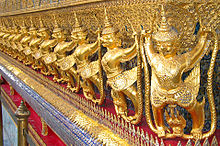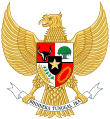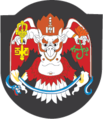Garuda
Garuda ( Sanskrit गरुड garuḍa , m.) In Indian mythology is a snake-killing, half-human, half-eagle-shaped mount ( Vahana ) of Vishnu , son of Kashyapa and Vinata . In Asian mythology, the Garuda also has the meaning of a divine messenger who brings people messages and instructions from the gods.
In many Asian countries (such as Thailand and Indonesia ) of the Garuda is also the depiction or Office seal by the authorities of the Government used.
Indian mythology

In primeval times, the old creator god and father of creatures Kashyapa, the “old turtle man”, once had two wives: Vinata , the sky, and Kadru , the earth. Kadru gave birth to a multitude of eggs from which various kinds of nagas hatched. Vinata only laid three eggs.
Jealous of Kadru and her numerous offspring, she broke the first egg. The being in the egg, however, had not yet taken shape: the lightning was created . The second egg contained a radiant youth. Also born prematurely, he had no legs. It was Aruna , dawn, the charioteer of the sun god Surya . Aruna was not so enthusiastic about his handicap, he cursed his mother and made her the slave of her rival, the snake mother Kadru.
When the third egg hatched, the mighty Garuda hatched. He immediately asked for his mother to be released. The Nagas, however, asked for the immortality elixir Amrita in return , which Garuda then had to steal from the gods.
This explains the eternal enmity between the Nagas and the Garuda.
The spiritual contrast between bird (eagle) and snake is also known to us in the west from the ancient Sumerians (see e.g. in Nietzsche's Zarathustra, also in the coat of arms and flag of Mexico ).
"The bird is invoked as" snake killer "or" naga killer "(nagantaka) or" snake eater "(nagasana). His real name is Garuda, gri from the root, "to gobble down". As a merciless destroyer of snakes, he is above the effects of poison with mystical power. "
With the spread of Buddhism, the Garuda came to Southeast Asia and to the north of Central Asia, where it is known to the Mongols as the Eagle Garide . According to a Central Asian myth, as in Iranian mythology, there is a “milk lake” in the sky. One of the stories is about a powerful ruler who wanted to give his daughter to the one who would bring him the wings of Garuda. A young hero set out with some hunters to find the mythical bird. Arrived on a mountain (the world mountain ), the group saw an increasing white discoloration in the sky above them. The hero asked what it was and was told that it was the milk lake. The dark in the middle of the lake is a forest in which the bird lives. Accordingly, the Milchsee was on the top of a mountain that reaches into the sky. The forest is nothing else than the tree of life , in whose tops birds generally reside and, according to several legends, also the Garuda.
Tibetan mythology
In addition to the snow lion , the dragon and the tiger , the Garuda is one of the four "dignities" or "power" or "symbolic animals" of the four cardinal points. On Tibetan prayer flags they are often located in one corner, complemented by a wind horse in the middle.
Garuda in Thailand
Garuda ( Thai : ครุฑ , krut ) is the personal emblem of the Thai king, who is commonly regarded as the incarnation of Vishnu. Buddhist kings of the current Chakri dynasty are named after Rama , a well-known incarnation of Vishnu: the late king, SM King Bhumibol Adulyadej , was Rama IX. As the only creature allowed to stand above the king's head, the Garuda is depicted on royal banners. Only religious or royal buildings, objects or papers have the honor of depicting Garuda.
The king also bestows the royal Garuda insignia on deserving companies and banks, so Garuda can look down on the busy people from the facades of well-known banks.
The Garuda is usually not a solitary bird. In Buddhist legends, large birds appear in flocks, the Garudas are their kings. They live on thorny trees in a forest called Garutmatvan , which is on the slopes of Mount Meru .
“In Cambodian architecture, not only Vishnu, but his entire temple is carried by Garuda. The bird appears here in great numbers, arranged in rows of caryatids, which hold the weight of the structure, which is intended as an earthly replica of Vaikuntha, God's heavenly dwelling. "
Thai artists adopted this symbolism by depicting a ring of garudas lifting the Chapel of the Emerald Buddha (see Wat Phra Kaeo ) in Bangkok into the air. However, this motif, rows of Garudas with Nagas in their claws, is relatively rare in Thailand.
Impressions from Thailand
Garuda, Wat Chang Kham, Wiang Khum Kham, Chiang Mai
Vishnu on Garuda in front of the Holiday Inn, Bangkok
Entrance door to Ubosot Wat Suthat , Bangkok
Garuda at a branch of the Siam Commercial Bank
Detail in Wat Phrathat Lampang Luang
Heraldic animal
The Garuda is one of the heraldic animals as a common figure in heraldry . In Europe this animal is not used as a figure in coats of arms.
In the coat of arms of Indonesia , the Garuda eagle is a normal golden eagle . A Garuda is also depicted in the coat of arms of Ulaanbaatar , the capital of Mongolia.
See also
literature
- Story of Garuda and the Snakes . In: Albert Wesselstá , transl .: Somadeva. The story of Djimutawahana . In: The most beautiful stories in the world. House book of immortal prose. Preface by Thomas Mann . Kurt Desch, Munich 1956, Part 2, pp. 717–729, this section pp. 725–729
Web links
Individual evidence
- ↑ Uno Harva : The religious ideas of the Altaic peoples (= FF Communications. No. 125 = Bd. 52, ISSN 0014-5815 ). Suomalainen Tiedeakatemia, Helsinki 1938, p. 86.
- ^ Robert Beer: The Handbook of Tibetan Buddhist Symbols. Serindia, Chicago IL, et al. a. 2003, ISBN 1-932476-03-2 , p. 67 .
- ^ Heinrich Zimmer : Indian Myths and Symbols. Key to the world of forms of the divine (Diederich's yellow row, 33: India). New edition. Diederichs, Düsseldorf 1981, ISBN 3-424-00693-9










